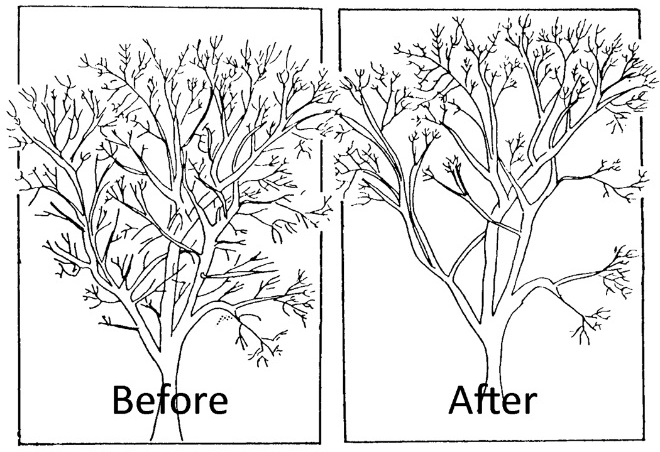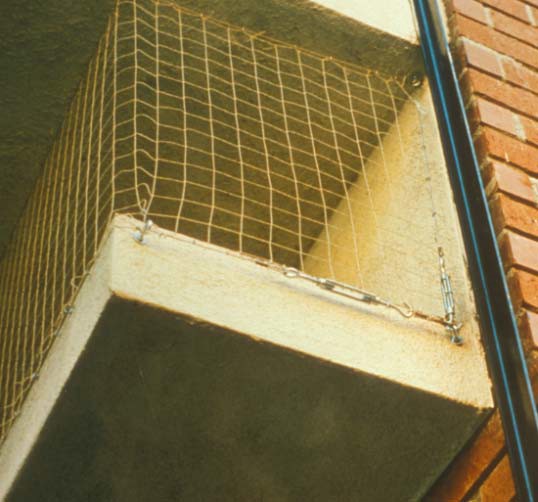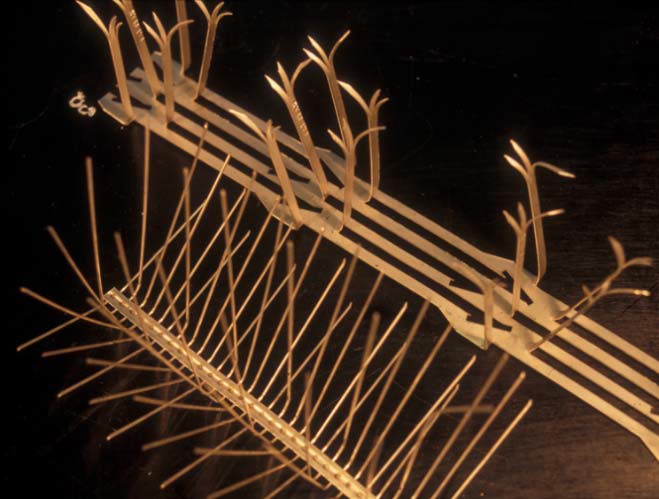Habitat Modification
- Remove food and water sources to reduce the attractiveness of a property to birds. Secure trash in covered containers to prevent birds from accessing food waste. Remove spilled seed from grain storage facilities. Encourage officials to enact local ordinances to ban feeding birds in public areas. Reduce the availability of free water by repairing leaky faucets, clearing drains, and grading surfaces to remove water. Ensure that water from air conditioner condensers does not pool on roofs or the ground. Angle gutters to permit
 |
Birds are attracted to trees with dense branches and leaf cover in the winter. Regular pruning of up to ⅓ of the branches can discourage birds from using trees as roost sites Contact an electric company if trees are near power lines. |
| Prune branches to help reduce the attractiveness of trees to birds. | |
 |
|
| Nets are used to prevent birds from accessing a porch | |
 |
|
| Nixalite® (bottom) and CatClaw® (top) are spiked products used to prevent bird roosting on the ledge |
Exclusion
- Nets with ½‐inch mesh will prevent birds from gaining access to a location. The use of nets is labor-intensive, but often is the best way to prevent birds from accessing rafters and building frontage with many ledges.
- Ledge products prevent birds from roosting on flat surfaces. The non‐electric products include spikes, wires, coils, 45° angle inserts, and specialty products.
Frightening Devices
- Several devices are available that employ audible and/or visual stimuli to frighten birds. Frightening only provides short-term damage reduction, as birds often become acclimated to the devices. Vary the timing, placement, and selection of devices to increase effectiveness. A wide variety of tools are available, such as distress calls, Mylar® tape, Mylar® balloons, scary-eye balloons, predator kites, and owl effigies. Shell crackers and other pyrotechnics are among the most effective devices. However, the explosive nature of these projectiles limits their use in urban areas. Always consult local authorities before using pyrotechnics. Some states consider starter pistols that project pyrotechnics to be firearms.
- Shell crackers and other pyrotechnics are among the most effective devices. However, the explosive nature of these projectiles limits their use in urban areas. Always consult local authorities before using pyrotechnics. Some states consider starter pistols that project pyrotechnics to be firearms.
- Avoid ultrasonic devices, as no reliable evidence indicates that they are effective. A Long Range Acoustic Device (LRAD) projects a high-decibel sound up to 153 dB out to 200 t<p class=”western”><span style=”font-size: small;”>o 300 yards. The farther animals are from the source of the sound, the lower the decibel level. The LRADs are useful for hazing birds out of trees, or off of surfaces
Repellants
- Tactile repellents (e.g., sticky gels) can be used to prevent birds from perching on ledges and other horizontal surfaces. These repellents are quickly fouled by dust or dirt and are best used indoors. Methyl anthranilate is a chemical frightening agent for birds. Professionals may use tactile repellents and fogging applicators to deter birds from warehouses and other large buildings.
The information on this webpage is based on the contents of the Wildlife Control Operator Professional Training Program published by the National Wildlife Control Training Program.